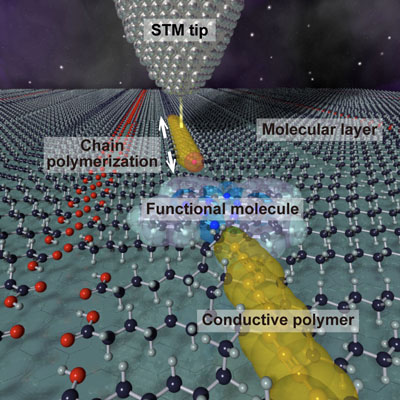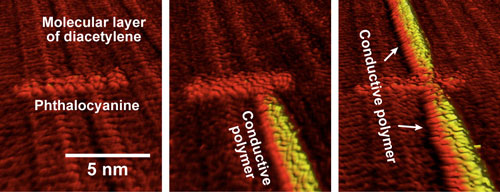| Posted: Jul 28, 2011 | |
Single-molecule nanoelectronics is getting closer to reality |
|
| (Nanowerk Spotlight) Using single molecules as electronic components like diodes, switches or transistors is the ultimate goal for future electronic nanotechnology devices (see for instance our Nanowerk Spotlight "Using quantum mechanics to turn molecules into transistors"). In order to explore the electronic properties of a single molecule, researchers have to make electrical contact between electrodes and molecules – and this has proven to be a big challenge. | |
| Though many efforts have been made to realize single-molecule electronics, it is still impossible to fabricate a practical single-molecule integrated circuit. One of the problems is the lack of viable methods for wiring each functional molecule. | |
| "In order to connect electrical wires to each functional molecule, most previous efforts concentrated on directly connecting metal electrodes to single molecules" Dr. Yuji Okawa, a researcher in the Nano System Organization Group at the WPI Center for Materials Nanoarchitectonics (MANA) in Japan, tells Nanowerk. "An essential problem with this strategy is that it will be difficult to make devices smaller than the conventional silicon-based devices because the metal electrodes will likely be fabricated using conventional lithographic techniques. The best way to reduce the width of wires to that of single molecules is to connect the molecules with conductive organic polymers. In particular, the connection via a strong covalent bond is an indispensable requisite for reliable electronic properties. However, there were no reports of a satisfactory way of connecting single molecules to conductive polymers." | |
| In work reported in a recent issue of Journal of the American Chemical Society ("Chemical Wiring and Soldering toward All-Molecule Electronic Circuitry"), first-authored by Okawa, an international research team (including scientists from the University of Basel, Forschungszentrum Jülich, and the ^California NanoSystems Institute at UCLA) has now demonstrated a novel method for controlling single molecule chemical reactions – a kind of 'chemical soldering'. | |
 |
|
| Schematic image showing chemical soldering. A relevant functional molecule is placed on a molecular layer of diacetylene compound. A probe tip of scanning tunneling microscope (STM) is used to initiate chain polymerization, which form a conductive polymer nanowire. Since the front edge of chain polymerization necessarily has a reactive chemical species, the created polymer nanowire spontaneously forms chemical bonding with an encountered molecular element. (Image: WPI Center for Materials Nanoarchitectonics) | |
| "About ten years ago, we found that a stimulation with the probe tip of a scanning tunnelling microscope could initiate a chain polymerization of diacetylene molecule" explains Okawa (see "Materials science: Nanoscale control of chain polymerization"). "Since the front edge of chain polymerization necessarily has a reactive chemical species, here we found that the created polymer spontaneously forms chemical bonding with an encountered functional molecule." | |
| In what is a key step in advancing the development of all-molecule electronic circuit, by using chemical soldering, the researchers were able to connect conductive polymer nanowires to a single molecule. | |
| This is also an important step forward in the varied field of basic science. This work provides a new technique of single-molecule synthetic chemistry on a solid substrate. The finished structure is a single functional molecule connected to linear conductive polymers that can be several hundred nanometers long, and is ideal for investigating the electrical transport properties of organic junctions. | |
| Okawa points out that these results also are useful for the detailed studies of chain polymerization mechanisms and carbene reactions. | |
 |
|
| Series of STM images demonstrating the chemical soldering to a single functional phthalocyanine molecule. The left image shows phthalocyanine molecules adsorbed on a molecular layer. Chain polymerizations were then initiated to connect one (center image) and two (right image) conductive polymers to a single phthalocyanine molecule. The created polymers are observed as bright lines in the images. (Image: WPI Center for Materials Nanoarchitectonics) | |
| The researchers believe that their chemical soldering method is applicable to many functional molecules in addition to phthalocyanine. "Therefore, this method is useful for wiring each component of single-molecule devices – such as molecular diodes, switches, memory bits, and transistors – and thus represents a key step in advancing the development of future single-molecule circuits" notes Okawa. | |
| The team is now planning two experiments for the next step. First one is to measure the electronic properties and functionalities (such as molecular resonant tunneling diode) of this system. Second one is to demonstrate the connection to more interesting molecules other than phthalocyanine. | |
| "The final goal of our research is to fabricate and demonstrate a single-molecule electronic circuit" says Okawa. | |
 By
Michael
Berger
– Michael is author of three books by the Royal Society of Chemistry:
Nano-Society: Pushing the Boundaries of Technology,
Nanotechnology: The Future is Tiny, and
Nanoengineering: The Skills and Tools Making Technology Invisible
Copyright ©
Nanowerk LLC
By
Michael
Berger
– Michael is author of three books by the Royal Society of Chemistry:
Nano-Society: Pushing the Boundaries of Technology,
Nanotechnology: The Future is Tiny, and
Nanoengineering: The Skills and Tools Making Technology Invisible
Copyright ©
Nanowerk LLC
|
|
|
Become a Spotlight guest author! Join our large and growing group of guest contributors. Have you just published a scientific paper or have other exciting developments to share with the nanotechnology community? Here is how to publish on nanowerk.com. |
|
